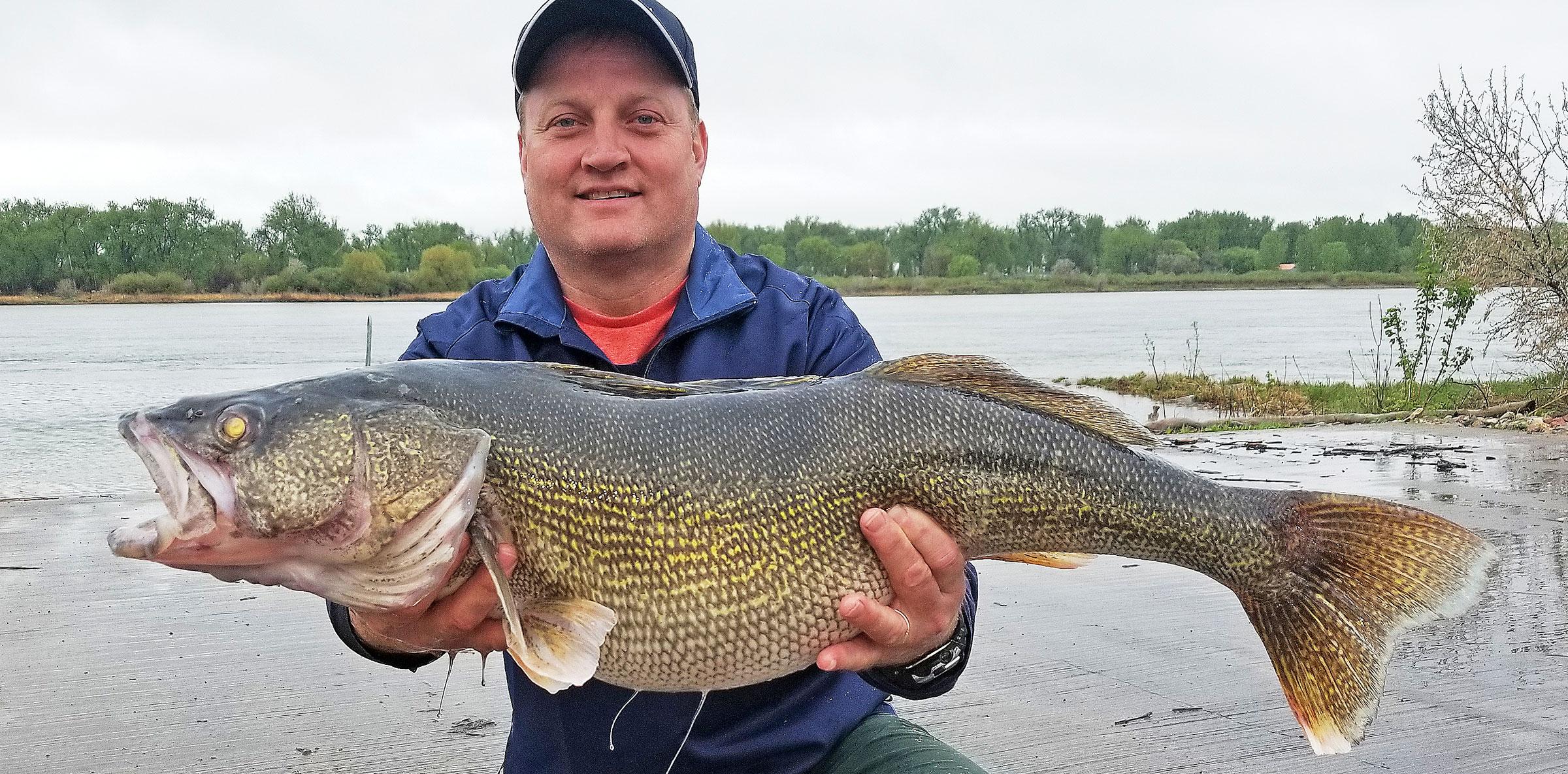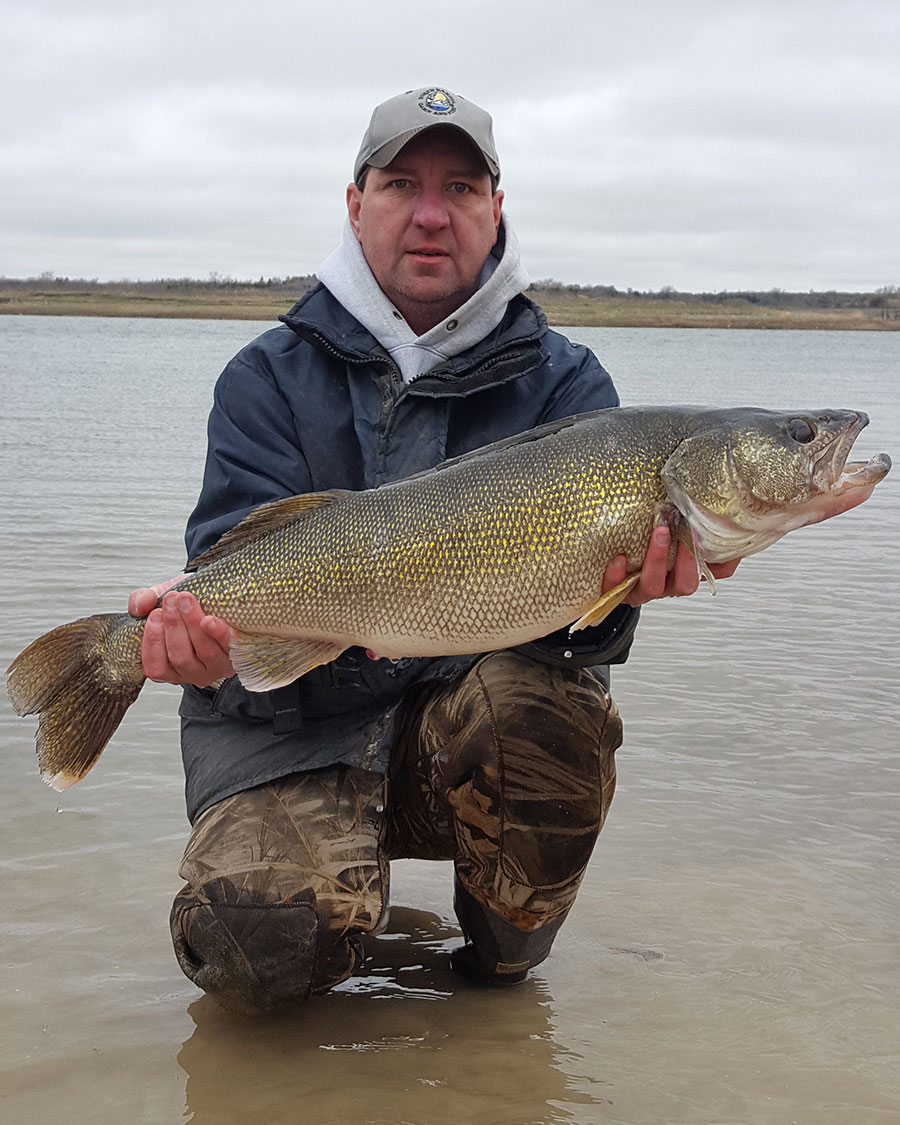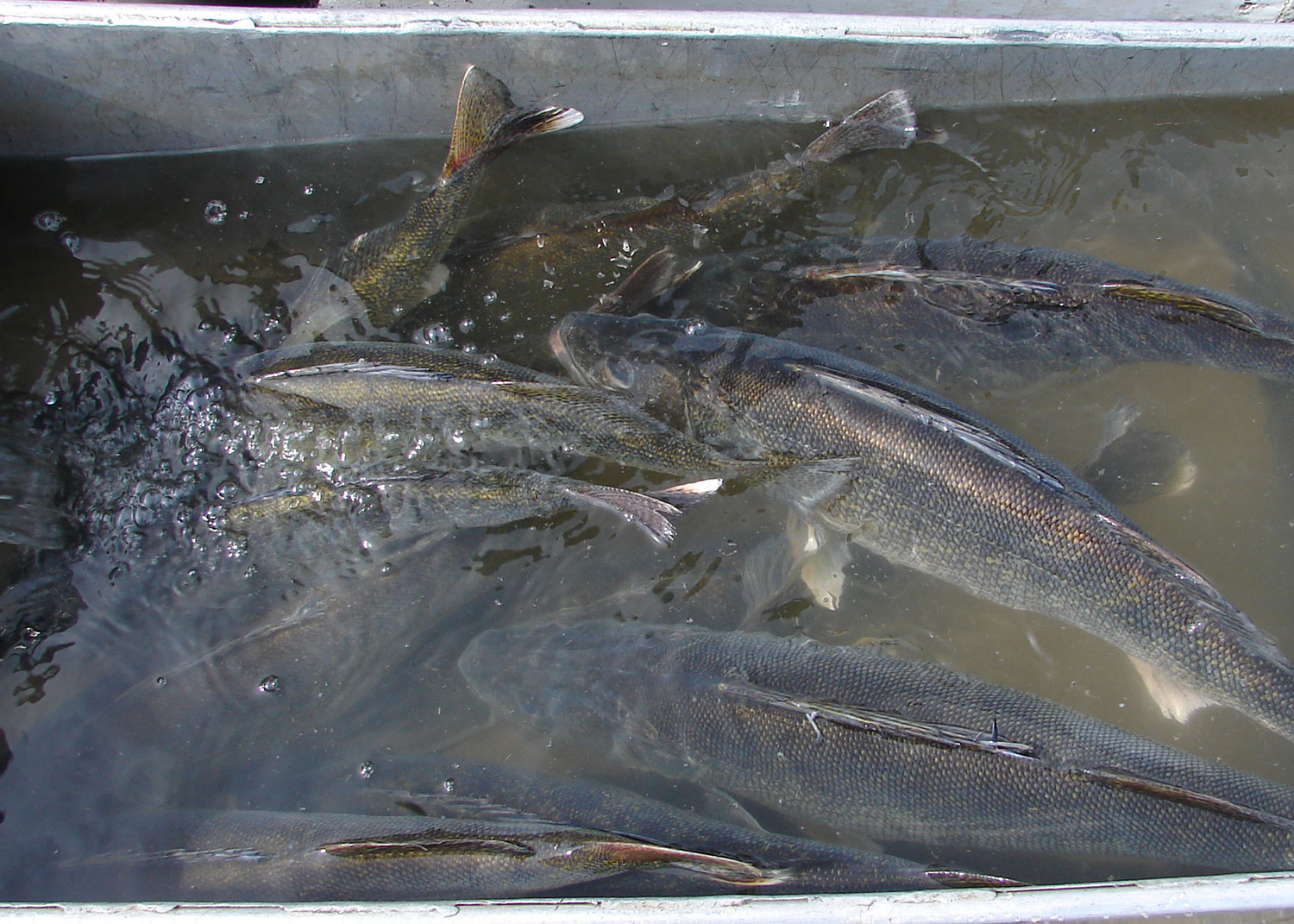

Weighing in on the Record Walleye
While Game and Fish Department fisheries managers readily recognized the new state record walleye caught in the Missouri River May 18, news of the 15-pound, 13-ounce fish didn’t necessarily come as a surprise.

Dave Fryda, Game and Fish Department Missouri River System supervisor, with a 16 pound walleye that fisheries biologists caught in a trap net during spawning on Lake Sakakawea in 2017.
“Given the recent history of good water conditions in lakes Sakakawea and Oahe, and the section of the Missouri River sandwiched between, I’m not surprised,” said Greg Power, Department fisheries chief. “Drought kills us in North Dakota. Fortunately, we’ve had good water conditions for 10-plus years, which has resulted in good forage production and good growth of predator fish in the Missouri River System. In short, there are groceries out there for growing good fish.”
Paul Bailey, Department south central fisheries supervisor, said the Missouri River System’s diverse forage base – from gizzard shad to cisco and other prey in between – is suited to producing big fish.
“In comparison, the forage base in our prairie walleye lakes is typically fathead minnows,” Bailey said. “With that kind of forage base, walleye in those waters, for the most part, are not topping 8 pounds.
“In the Missouri River System we’re consistently seeing walleye in the 10- to 14-pound range, which has much to do with what the fish are eating,” he added.
There was concern about the Missouri River’s forage base following the 2011 flood that, for one, flushed the majority of rainbow smelt from Oahe downstream.
“There is no way the Missouri River System could have produced the kind of walleyes we are seeing today following the 2011 flood,” Bailey said. “A 27-inch walleye in 2013, for example, might have weighed 6-7 pounds, but now that fish weighs 9 pounds with the improved, diverse forage base.”
Record Walleye
Neal Leier of Bismarck caught the record walleye on a rainy Friday near the Fox Island boat ramp. He jigged his plastic bait maybe five times before hooking into what felt like a log when he got the fish on the reel.
“The biggest walleye I ever caught before that was about 24 inches,” he said. “I don’t know how much it weighed.”
Other than doing a number of interviews and fielding a lot of congratulatory phone calls, Leier said his life hasn’t changed any.
“I really haven’t been out fishing that much since then,” he said.
Leier’s 32½-inch walleye was the fish that a lot of anglers had been waiting for. A fish heavy enough – by 1 ounce, it turns out – to best the 15-pound, 12-ounce walleye from Wood Lake in Benson County that stood as the state record for nearly 60 years.
“I heard from a lot of people who were glad to see the record broken,” Leier said.
It’s been repeatedly reported that the Wood Lake walleye wasn’t actually caught by Blair Chapman, but found dead, floating on the lake’s surface.
Whatever the case, the Wood Lake walleye no longer tops the charts.
“For nearly 60 years it stood as the record fish and for nearly 60 years there has been controversy,” Power said. “Today, both are gone.”
While a new state record walleye makes for good conversation in the angling world, Bailey said there’s more to it than that.
“This record walleye points to the fact the current fishing regulations are working and producing not only state record fish, but other big fish,” Bailey said. “Under current Game and Fish Department regulations, anglers are not over-harvesting big fish, but allowing for the trophy component of the Missouri River System to continue.”
New Standard
Of course, anglers in search of big walleyes know the standard – 15 pounds, 13 ounces – they must eclipse to set a new state record. And Power doubts, based on what Game and Fish Department fisheries crews are finding in their spawning nets in spring, teamed with continued help from Mother Nature down the road, it will take nearly 60 years to see a new mark set.

Brandon Kratz, district fisheries supervisor in Jamestown, with a big female walleye that was netted during spawning on Sakakawea.
In spring 2017, Department fisheries crews netted a 15-plus-pound walleye from the Missouri River and a 16 pounder from Lake Sakakawea. Additionally, South Dakota Game Fish and Parks reported a couple of 17-pound walleye netted this spring in Lake Oahe.
“In the last few years, we’ve seen many 10-plus-pound walleyes in our nets in the Missouri River System in spring,” Power said. “Unless the midsummer high runoff conditions don’t get even higher, it might only be another year or two for a new state record because the conditions in the Missouri River System are so good.”
Then again, there are a number of factors that come into play, a little luck included, to put a record fish in the boat.
While not taking anything away from Leier’s accomplishment, the fact that the fish he caught was still heavy with eggs on May 18 was unusual.
“The peak of the walleye spawn in the Missouri River around Bismarck and the North Dakota portion of Oahe is April 20-25,” Bailey said. “Some fish didn’t spawn this year because of the late spring. The record walleye was one of them … she should have spawned weeks earlier. She was likely in the process of absorbing her eggs.”
Power said there were reports of some walleyes that measured 33 inches or longer that were caught in the Missouri River in spring. Yet, all of those fish had already spawned.
“A walleye fat with eggs means two or three extra pounds,” Power said. “Any of those fish could have been a state record.”
Leier said he understands that his record could be broken, and he’s OK with that. But it likely won’t be a fish caught in summer, but a prespawn female carrying the weight of thousands of eggs in spring.

Walleyes taken during spring spawning on Lake Sakakawea.
“In the Missouri River, anglers can access prespawn females heavy with eggs,” Power said. “Typically, the river is open to fishing three or more weeks before the spawn.”
On Sakakawea, where the ice comes off later, getting on the water in that short window before the big walleyes drop their eggs is difficult.
“Certainly, because of the smelt numbers, habitat conditions, good growth and some good genetics, there are some walleyes in Sakakawea in that record range,” Power said. “Unfortunately, accessing those fish in early spring is many times tough to do.”
Fish Responsibly
Power said if a record walleye isn’t caught in spring, it could come from the depths of Lake Sakakawea in, say, October or November when anglers are targeting big fish that are holding deep.
He encourages anglers fishing in deep water – 25 feet and deeper – to keep what they catch. The reasoning, Power said, is because many fish caught from those depths likely don’t survive after they are released because of extreme changes in pressure on their journey to the net, causing swim bladders to expand.
(Editor’s note: For more on fishing responsibly and catch-and-release tips when the situation supports a safe return to the water, see the May 2018 issue of North Dakota OUTDOORS.)
“Some anglers are practicing catch-and-release under these circumstances and likely think they are doing the right thing,” Power said. “Unfortunately, many of the fish caught in deep water and released aren’t surviving.”
